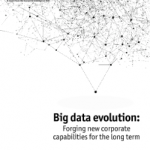 In the previous post, I played devil's advocate over the very concept of a data strategy. I discussed the limitations of all business strategies, including and especially data ones.
In the previous post, I played devil's advocate over the very concept of a data strategy. I discussed the limitations of all business strategies, including and especially data ones.
Today I'll turn off the cynical side of my brain. At a high level, I'll explore the two necessary components of a contemporary data strategy.
Over the last decade, the field of competitive intelligence has become increasingly important. In general, competitive intelligence consists of two components: offense and defense. Let's look at each.
Offense
The idea here isn't complicated: With timely access to valuable data, organizations can legally gain a competitive advantage. (I won't open up a hornet's nest here by addressing the ethics of hacking and corporate espionage.) An example will illustrate the point.
More than six months ago, embattled social network Twitter was set to announce its quarterly earnings. Ho-hum. Business as usual, right?
As is custom for publicly traded companies, Twitter scheduled the investor call after the markets closed for the day (read: 4 pm EST and 1 pm PST). Yet, a company named Selerity somehow tweeted the following nearly an hour before the bell rang.
#BREAKING: Twitter $TWTR Q1 Revenue misses estimates, $436M vs. $456.52M expected
Equipped with that information, Selerity clients were able to profit handsomely in after-hours trading. The incident caused some pundits to question management practices at Twitter.
Defense

But playing offense alone can be costly. It's never been more important to play defense as well. Again, several examples illustrate the point.
Why is Google resurrecting its much-maligned social network Plus? As I wrote recently, the answer can be summed up in a single word: data.
Further down Sand Hill Road, companies correctly view scraping “their” data as a tremendous threat. Want proof? Give it a shot on Facebook and, if caught, you will probably find yourself banned. Zuck understandably doesn’t want competitors and other third parties gobbling up reams of Facebook data. It is without question one of the company’s most valuable assets.
And then there's Apple and its ambitious Project Titan. In The High-Stakes Race to Rid the World of Human Drivers, Adrienne LaFrance writes about the cut-throat world of the driverless car. From the piece:
There is a joke in the Bay Area that if you know somebody in the vehicle space and they left their old job but they haven’t updated their LinkedIn, they must be at Apple.
While Apple famously doesn't monetize customer and user data, Tim Cook is no idiot. He understands that an ostensibly innocuous update to a new hire's LinkedIn profile could result in a catastrophic leak.
Simon Says: Play both sides of the field.
Make no mistake: The data wars are alive and well. To use a football analogy, organizations that ignore the defensive side of a data strategy may find themselves on the wrong side of a 42-37 score.
Feedback
What say you?
In the next post in the series, I'll discuss whether a good data strategy can make an organization more competitive.
